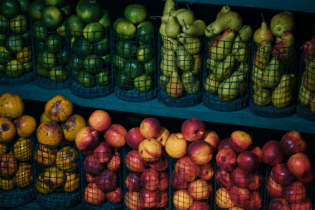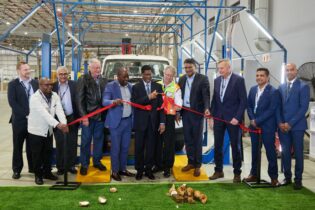Rebuilding a region ravaged by decades of conflict takes time. As the wounds heal, new infrastructure opens up endless opportunities. This is a success story in the making.
In May 1997, the Republic of Namibia and the Republic of Angola formally agreed to create the Trans-Cunene corridor as a means of opening up northern Namibia and southern Angola to economic development opportunities – much needed after the protracted 27-year civil war between the principal protagonists, the Popular Movement for the Liberation of Angola (MPLA), the National Front for the Liberation of Angola (FNLA) and the National Union for the Total Independence of Angola (UNITA). The corridor, comprising road, rail and air links, runs between the Port of Walvis Bay in Namibia and Lubango, near the small Port of Namibe, in south-western Angola. By road, it is a distance of 1 551 km, with a (sensible) transit time of four days. In all likelihood, the Trans-Cunene Corridor will link up with the east-west Benguela Corridor at Lobito and/or Huambo in west-central Angola. The road to Santa ClaraFrom Walvis Bay, the road, a little narrow for two big trucks passing each other, but they do, travels north-east through the desert to Usakos, an old watering station, and then on to Karibib, which is well known for its aragonite and marble. This initial 210 km section of the road is in good to fair condition. Just outside Karibib, on the Windhoek road, a right turn south takes you onto a sweeping left-curving onramp north to Omaruru, a town famous for its dinosaur footprints. From here it’s on to Otjiwarongo, where fat cattle graze, and on to Otavi, a famous old mining town, after which comes Tsumeb, the ‘gateway’ to the north. All along this 384 km section, work teams keep the road well maintained. And, while travelling this road, keep an eye out for the frequently-sighted bush pig (some of them get quite big), and the occasional antelope, crossing the road. From Tsumeb, the road travels north-west to Ondangwa, the residence of Ovambo kings and on to Oshakati, a once military base that has now been now civilised. This 250 km stretch of road is in good condition. From here the road continues 56 km north-east to Oshikango, Namibia’s border town with Angola. Oshikango is Ovamboland’s reputed shebeen capital and it would seem Santa Clara, a stone’s throw away across the border in Angola, has been duly influenced. The Oshikango/Santa Clara Border Post
There are a number of things one needs when travelling to another country, the two most important of which, before you even leave, are money and fuel. The Angolan currency is the Kwanza, of which Kz100 will buy R8.42.
Unleaded petrol and diesel are readily available throughout the country. All fuel stations are well equipped and each town always has petrol and diesel (or at least diesel) available. Some of the new petrol stations also have lead-free petrol. With these basics dispensed with, we now look at what documentation is needed. Except for Namibian citizens, a visa is required. This will set you back R1 800, with a 30-day waiting period, or R5 000 for a two-day waiting period. You will need an international driver’s licence or a SADC driver’s licence. Certificates proving your inoculation against yellow fever and vaccination against cholera are compulsory. Certification of typhoid, hepatitis A, tetanus and polio vaccinations are recommended, as is taking bottled water. Malaria is a medium to high risk. And, as with travelling to foreign destinations, having medical insurance cover is strongly recommended.
As to your vehicle and insurance, comprehensive vehicle insurance is compulsory, as is third-party insurance, which you can buy for R230 in Oshikango. The original vehicle registration documents, as well as certified copies (the registration document from which you cut the disc too) need to be on hand for inspection at the border. If you owe money to a bank for the purchase of the vehicle, you will need a bank letter, with dates, permitting you to take the vehicle across the border. The bank letter and licence documents have to be certified by a commissioner of oaths (find out beforehand where your vehicle’s engine number is displayed).
You need a letter of invitation from the person or company you are visiting or delivering goods to. Your name and passport number must appear on the letter. Get a police clearance certificate from the South African or Nambian police, whichever is necessary. As a trucker, you will need your manifest, commercial invoice, F178 for goods over R50 000, SAD 500 (Bill of Entry), SADC 500 (Certificate) and packing list. It is important that you make seven to ten certified copies of all documents.As a road user you will need a road permit, which will costs about Kz3 850. Make sure you have a ZA sticker on your vehicle and emergency equipment, including an emergency triangle and reflective jacket. As to what you may take into Angola, general items for personal use, gifts or souvenirs up to the value of R3 500, including 400 cigarettes or 500 g of cigars or other tobacco products, two litres of wine and one litre of spirits, 250 ml of eau de toilette or 50 ml or perfume and aftershave, or similar products, are permissible. Have all electronic equipment such as cameras, video recorders and computers certified by the police or customs. There are restrictions on firearms and ammunition, pornographic materials, plants from infected areas, gaming machines, pure alcohol (such as methylated spirits), animals without corresponding certificates, dangerous medicines or foodstuffs and fiscal or postal stamps or valuables. Don’t bring any meat back. It will be confiscated in Namibia.
The Namibian border authorities are very strict. Remember that the border times are 08:00 to 18:00. And, very importantly, remember that Angola is an hour behind South Africa. The road to Lubango
Crossing a border always seems to bring on a new atmosphere. Perhaps it’s just the fact that you are in a different country. From Santa Clara the road continues 40 km in a north-westerly direction to Ondjiva (formally Villa Pereira de Eca). Its only claim to fame is being the the administrative capital of Cunene Province. After continuing in a north-westerly direction for a while, the road turns to take an almost westerly route to Xangongo (previously Villa Rocados), a town 99 km further up the road, which, up until this point, is in a good condition. Xangongo was a focal point in the civil war and the site of a number of battles between Cuban and South African forces. Old rusted Russian T26 tanks destroyed by the South Africans litter the bush. Once you cross the mighty Cunene River, travelling in a north-westerly direction again and now on your way to Lubango (previously Sá da Bandeira), the road becomes truly African. For 292 km you travel along a dirt road, which in rainy season becomes a challenge for any driver, especially trucks. Railways
The Trans-Cunene Corridor’s road infrastructure is complimented by the northern railway line, which comprises a long established section, a recently completed section and a soon-to-be-completed section. The railway line doesn’t deviate from the road route except to bypass Karibib.
From Walvis Bay, the now long-established section of the railway line travels north-east to Tsumeb. From here, the recently completed railway line travels north-west to Ondangwa and the soon-to-be-completed section, from Ondangwa to Oshikango, will end with the last stretch, a short piece, to reduce congestion at the Oshikango border post, one kilometre into Angola at a railway station yard close to Santa Clara. There it stops. The Angolan authorities intend building a railway line from Lubango to Santa Clara at some point in the future.
TransNamib is the national transport logistic provider in Namibia. This parastatal specialises in break bulk and containerised freight transport and is able to provide a dependable, cost-effective cargo delivery service, through a combination of rail and road transport, to the greater SADC region. Airlines
If you do not wish to travel by rail or road, you can fly – yourself or use Air Namibia, SonAir, SAA Express or TAAG Angola Airlines. There are three airports along the Trans-Cunene Corridor, all of which are IATA registered and approved. These are: • Walvis Bay Airport serves Walvis Bay, a town in the Erongo Region of Namibia. The airport is found approximately 15 km east of the town at an elevation of 91 m above sea level. It has one runway designated 09/27, with an asphalt surface measuring 2 134 m by 30 m, with extensions on either side, giving it an overall length of 3 500 m. Air Namibia flies from Walvis Bay to Windhoek and Cape Town, while South African Express flies to Walvis Bay from Cape Town and Johannesburg.
• Ondangwa Airport serves the town of Ondangwa in the Oshana Region of Namibia. The airport is found 5 km northwest of the town at an elevation of 1 097 m above sea level. It has one runway designated 08/26, with an asphalt surface measuring 2 987 by 30 m (9 800 × 98 ft). It also has a secondary runway measuring 1 348 m by 30 m that is designated 16/34. Air Namibia flies between Walvis Bay and Ondangwa.
• Lubango Mukanka Airport serves Lubango, the capital of the Huíla Province, in Angola. The airport is found at an elevation of 1 761 m above sea level. It has one runway designated 10/28, with an asphalt surface measuring 2 917 m by 45 m. Air Namibia flies from Windhoek to Lubango and on to Luanda, SonAir flies between Lubango and Luanda, and TAAG Angola Airlines flies from Lubango to Huambo, Luanda and Windhoek







